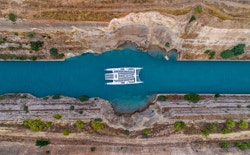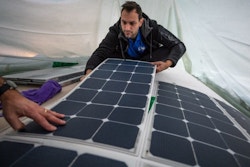‘Haute Couture’ solar panels for Energy Observer
Energy Observer has been examined with a fine-tooth comb. Every nook of its decks, floats and infrastructure is now fitted with custom photovoltaic panels. A technical conundrum for Hugo Devedeux, on-board engineer who is in charge of the solar component of the experimental catamaran optimization project.

For several weeks, the marine vessels have been land vessels. Energy Observer, on land in Saint-Malo, is in the process of optimization. The three major developments, the addition of wings, the hydrogen system and the redeployment of photovoltaic panels, are progressing simultaneously.
Hugo Devedeux, on-board engineer, has taken on the solar component. At the end of 2018, the experimental catamaran was examined with a fine-tooth comb. Each square centimeter of the decks of Energy Observer able to receive a photovoltaic cell has now been identified and will be put to profitable use.
Around one hundred panels are to be changed
“Last season, we had 140 square meters of solar panels. One part of this surface in two-sided panels and the other part spread over the flat deck and infrastructure of the vessel. It is the latter that will be replaced. This represents around one hundred panels to be changed.”

Hugo working on the solar panels
In partnership with Solbian Energy Alternative, flexible panels with templates tailored to meeting the exact requirements of the vessel will be developed.
“Photovoltaic cells are known and widely proven, but their shape and power are suitable for our demand. We need a lot of power, on a constrained surface. We will also take the opportunity to refit one part of the vessel with an anti-slip version recently proposed by Solbian. We have tested this type of panel on floats this summer and realize that they are particularly efficient.”
Areas of conflict
But the bulk of the engineer’s work was designing the puzzle. Whilst, on the catamaran, technicians removed the old panels, Hugo Devedeux ‘played’ Tetris on his computer. On his screen, squares and rectangles fill the cells as well as far more complex patterns.
“We’re sticking with the same cell format and the number of cells that must be integrated on the surfaces must be at its maximum. Down to the very last cell. The number of cells determines the power of a custom-built panel.”
This is for the surfaces. But the engineer’s real conundrum was defining in the most accurate way the panel fields according to the desired voltage. The power produced by ‘stacking’ the photovoltaic cells determines the number of converters required and especially the number of solar fields grouped by voltage zones.
“We have set a voltage of 28.6 volts per field, which represents a grouping of 42 cells.”
Finally, there are 28 square meters of additional solar panels that are now fitted on Energy Observer, providing a maximum power which should increase by 5,000 watts.
These new panels were installed at the end of January. From now on, the team will be focusing on aircraft-type wiring and connectors. Another major project.